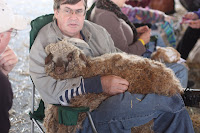When she's not taking photographs of the artfully-swirled cream in her cup of java mochalatta, Clara Parkes writes books. Really excellent books, as a matter of fact. Today's No-Bull Book Review examines her latest, The Knitter's Book of Socks: The Yarn Lover's Ultimate Guide to Creating Socks That Fit Well, Feel Great, and Last a Lifetime (Potter Craft 2011; MSRP $30, available as of the time of this writing for $17.85 via the link).
(Potter Craft 2011; MSRP $30, available as of the time of this writing for $17.85 via the link).
I first encountered Clara Parkes through her excellent newsletter, Knitter's Review, and the message boards that accompanied it. I have always loved Clara's in-depth yarn reviews, her emphasis on small-producer and single-breed wools, and her willingness to share her technical expertise though both her newsletter and message boards. Clara's first two books (The Knitter's Book of Yarn and The Knitter's Book of Wool ) are wonderful, information-packed volumes that should be on every knitter's bookshelf. They also feature some lovely patterns, too. It's no surprise that The Knitter's Book of Socks will take its place next to them, as a must-read book for the sock knitter. Let's take a closer look at what's inside.
) are wonderful, information-packed volumes that should be on every knitter's bookshelf. They also feature some lovely patterns, too. It's no surprise that The Knitter's Book of Socks will take its place next to them, as a must-read book for the sock knitter. Let's take a closer look at what's inside.
Knitter's Book of Socks begins with a brief introduction, in which Clara sets out her goal: to educate readers about "the art, science, and sheer pleasure of knitting socks from the yarn up." By using the specific sock yarn as starting point, Parkes hopes to prevent sock knitting disasters that might result from a bad combination of sock and yarn.
Stepping Stones, by Clara Parkes
Chapter 1 is titled "What a Sock Needs," and we learn in the introductory section that a sock yarn needs three qualities: elasticity, strength and absorption. Parkes walks the reader through each of these qualities, discussing what elasticity is and how to measure it; different aspects of strength, including strength to resist abrasion and tensile strength; and moisture management. She finishes with a nod to a fourth, more abstract factor: what I think of as the yarn's charisma -- whether the yarn feels good to wear and work with.
Hickory, by Jane Cochran
Chapter 2 covers the fibers that are used to create sock yarns, not only covering types of fiber (wool and other protein fibers, plant-derived fibers like cotton, synthetic and others) but also issues like blends, the fineness of the fibers and staple length.
Chapter 3 looks at specific types of yarn, instructing the reader about twist, singles vs. plies, even cable-spun and corespun yarns -- all excellent stuff that often is overlooked in discussions of yarn.
Chapter 4 gives the knitter some tips on how to make adjustments to a yarn to compensate for natural tendencies that can affect its suitability as a sock yarn. For example, Parkes gives some guidance on how to use your stitchwork to increase the elasticity of the socks (if you are working with a less-than-elastic yarn); how to improve the strength of a less-durable yarn; and discusses the use of wooly nylon as reinforcement.
Veil of Rosebuds, by Anne Hanson
If your mind starts spinning from the vast amount of valuable information in the beginning chapters, you can always take a break and refer to Chapter 5, the patterns. Parkes presents a selection of 20 sock patterns from leading sock designers, including Cat Bhordi, Cookie A, Lucy Neatby, Nancy Bush and Ann Budd.
Buddleia by Marlaine Bird
There's a great variety of styles included, from stranded
Strago by Jared Flood
and eyelets
Prana, by Cirilia Rose
to cuffs
Lady Tryamour, by Sivia Harding
even unique multidirectional colorwork:
Percheron, by Kathryn Alexander
But of all the gorgeous patterns, my favorite is a lovely one called "Tutu," designed by Melissa Morgan-Oakes and knit up in Black Bunny Fibers Stella yarn:
Tutu, by MMO
The patterns feature charts (in color where appropriate); close-up shots to show off specific design features; notes to help the knitter with unusual techniques; and extensive descriptions that explain how the features of the specific design illustrate the technical information given in the beginning of the book. Sizing varies depending on the pattern; some of the more unusual designs are shown in one size only, but many include two or three different sizes.
The pattern section is followed by a "Resources" section detailing how to care for your socks; explanation of abbreviations and techniques; a chart showing foot size and how it relates to sock sizes; and a bibliography.
The book is hardcover; approximately 208 pages; with lots of photographs and inset boxes; and the mouth-watering photography is by Alexandra Grablewski.
When you really love yarn, especially sock yarn, like I do, it's a real treat to encounter a book as informative and easy to read as it is beautiful. The Knitter's Book of Socks is such a book, and thanks to the generosity of Potter Craft, I have a free copy of The Knitter's Book of Socks to give away. Leave a comment to this post by midnight, Wednesday, November 2. I will use the random number generator to pick a winner and announce it the next day. One comment per person, please! And makes sure you include an email or I can reach you through your Blogger comment login.































































